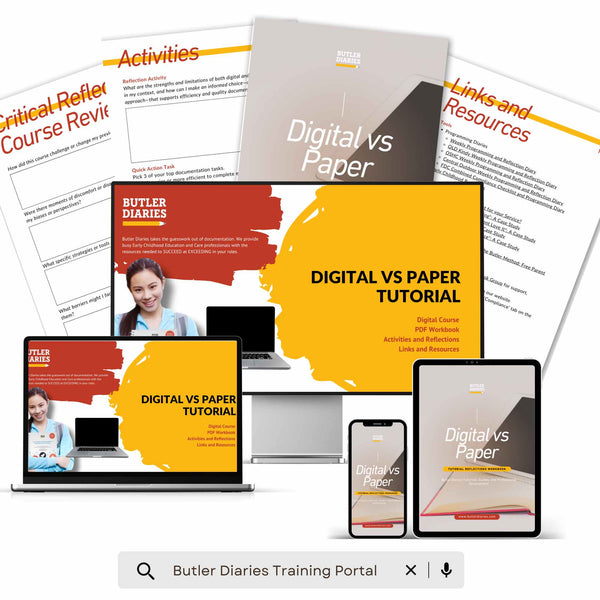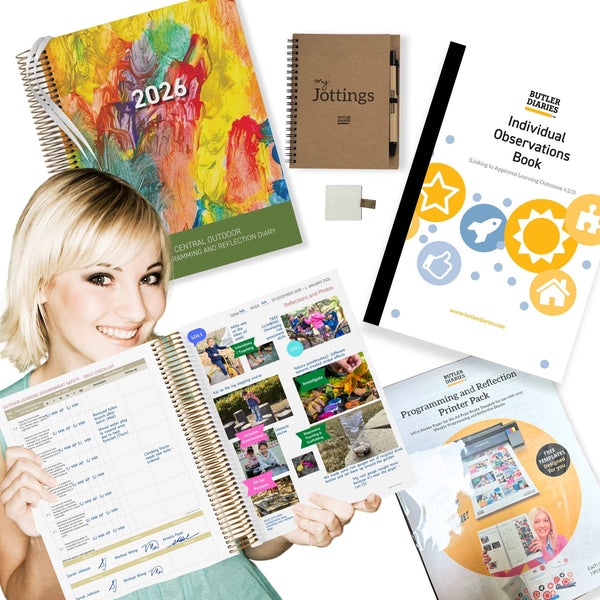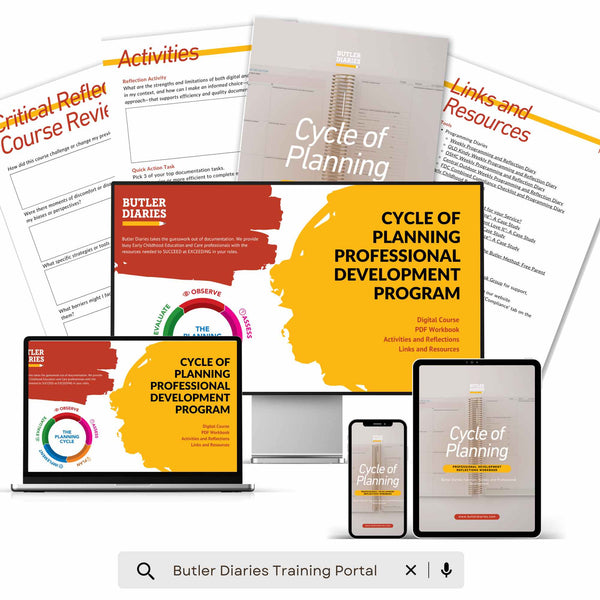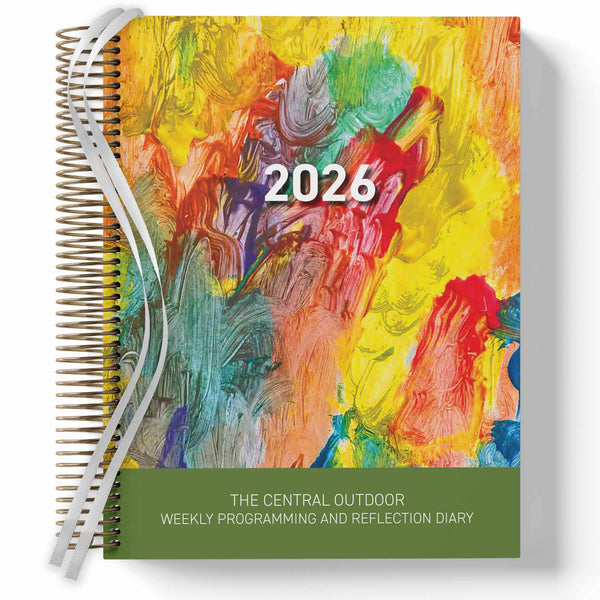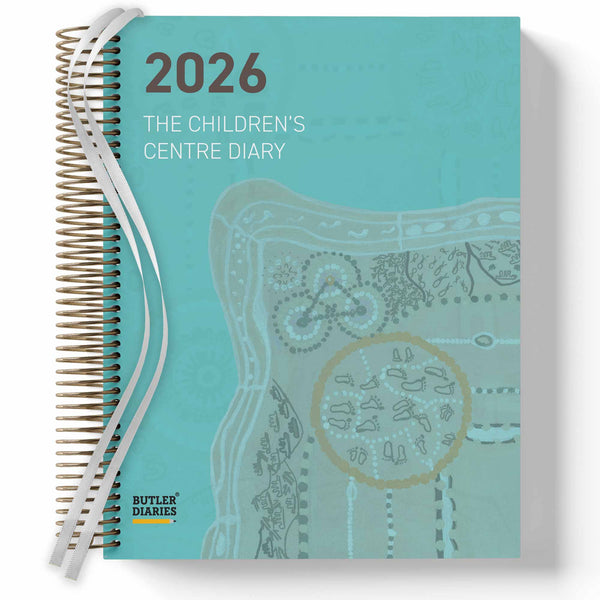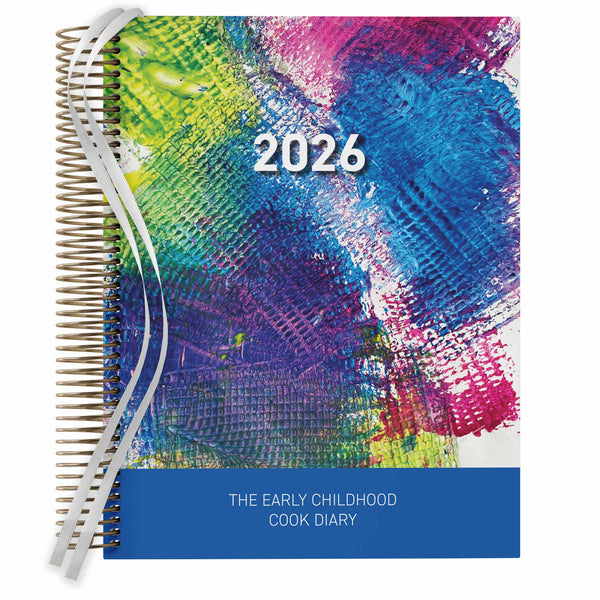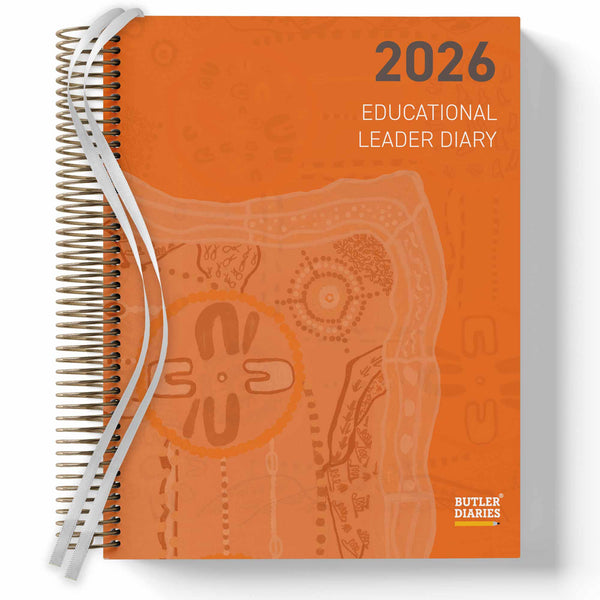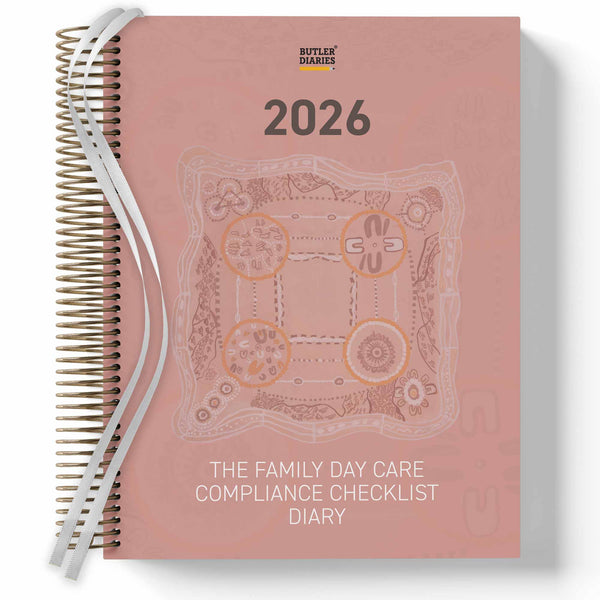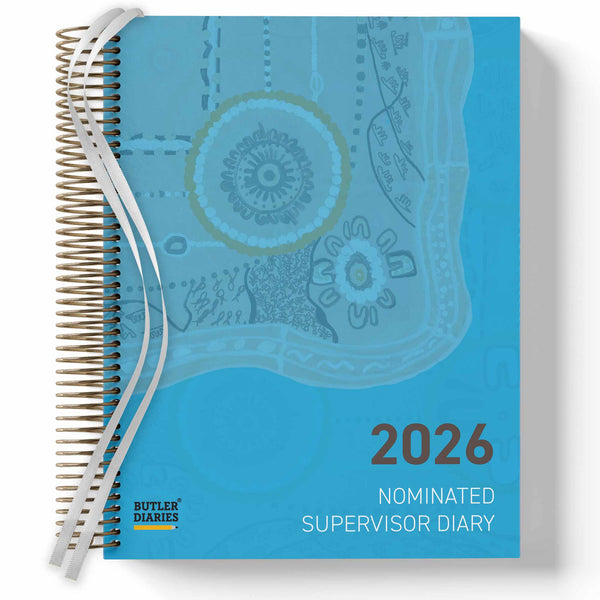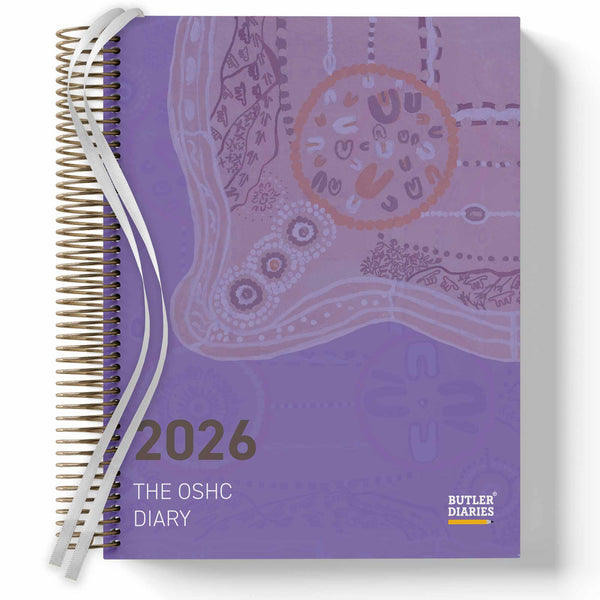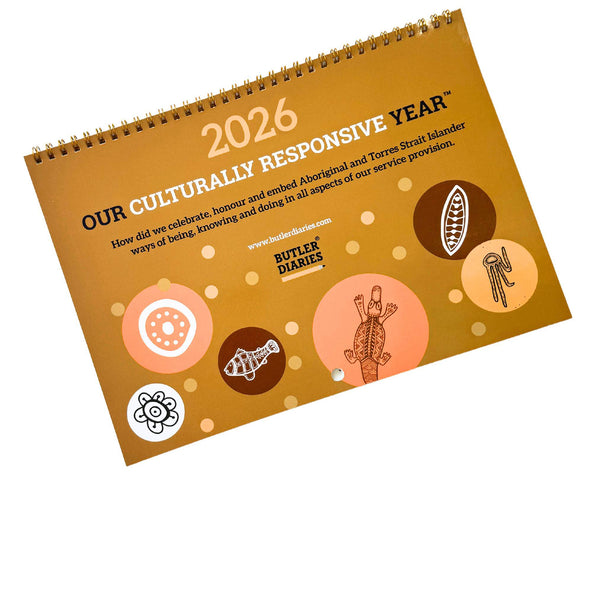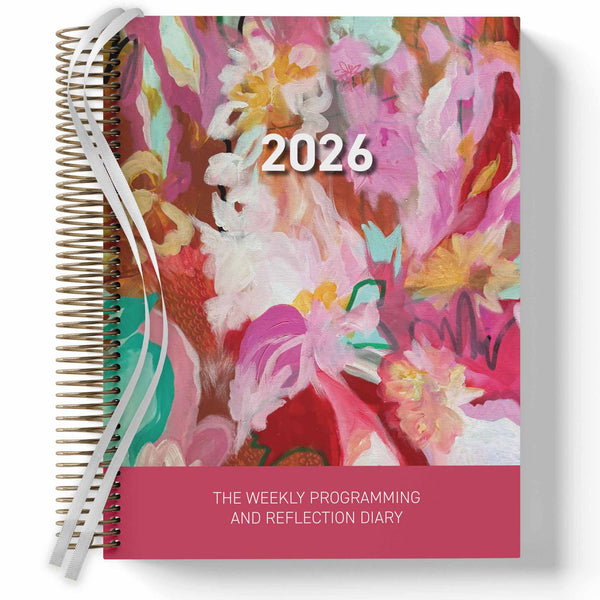When it comes to planning, early childhood educators in Australia face a tough choice: digital or paper planners. Both have pros and cons, and the right option depends on your workflow, compliance needs, and personal preferences. Here's a quick breakdown:
- Digital planners: Offer features like templates, automated reminders, multimedia integration, and cloud access. They simplify compliance and collaboration but require training and can cause screen fatigue.
- Paper planners: Provide a hands-on, distraction-free experience with better memory retention. They're always accessible but can be bulky, harder to share, and prone to damage.
Quick Comparison
| Feature | Digital Planners | Paper Planners |
|---|---|---|
| Cost | $100–$1,000 upfront | $10–$100 upfront |
| Ease of Sharing | Real-time updates, multi-user | Physical handover required |
| Storage | Minimal digital storage costs | Higher physical storage costs |
| Accessibility | Needs power/internet | Always available |
| Error Rate | Lower (4.4%) | Higher (24.4%) |
| Customisation | Low customisation options | Handwritten, personal touches, and by combining with digital templates |
| Screen Time | Increased | None |
Choosing the right planner involves considering your centre's tech setup, compliance requirements, and whether you prefer digital convenience or the tactile feel of paper. Some educators even combine both for the best of both worlds.
Digital vs Paper planner : Choose Hybrid Planning
Many services are embracing a hybrid approach to planning, using both digital and paper documentation to create a more flexible and responsive system. For example, one of our long-term customers, Rachel from Brady Bunch, shares how her team uses the Weekly Programming and Reflection Diary to plan and track learning outcomes, which are then transferred into Storypark to communicate learning with families through observations. This allows for meaningful reflection on paper while still engaging families digitally.
Another example of this is our Weekly Programming and Reflection Diary paired with our Programming and Reflection Printer Pack. Together, they provide the benefits of a paper planner with the ease of technology to add photos and avoid glue and sticky fingers.
All of our Diaries are designed to support this kind of blended practice, offering a balanced, inclusive, and efficient way to meet the diverse documentation needs of educators, children, and families.
“There is no prescribed method in the National Law or Regulations for documenting the educational program, assessments or evaluations. There are many different electronic, visual and paper based ways to document. A service can explore a range of styles and methods to determine what works best for their children, families and educators.” – NQF Review 2019
This provides you the freedom to take the best of both worlds and limit the downsides of either method.
 Digital Planners in Early Childhood Education
Digital Planners in Early Childhood Education
As administrative demands grow, educators across Australia are turning to digital solutions to simplify their workflows. These tools not only streamline documentation but also encourage collaboration and help meet the requirements of the National Quality Standard.
Features and Benefits of Digital Planners
Digital planners come equipped with templates tailored to various educational frameworks and centre needs. These templates cover everything from daily observations to developmental assessments, helping educators maintain consistency while addressing each child’s unique needs.
Automation is a key advantage. With features like automated reminders and cloud-based access, educators can meet deadlines and access documents from any device. This is particularly important, given that over 10,000 Early Childhood Education and Care Qualifications were revoked in 2024.
Multimedia integration is another standout feature. Photos, videos, and audio can be added directly to observations, creating a richer and more complete picture of a child’s learning journey.
Communication is also enhanced. Parent portals allow families to track their child’s progress in real time, while integrated messaging supports quick updates about daily activities or achievements. Additionally, secure data storage and automated backups ensure sensitive information remains protected.
Using Digital Planners in Early Childhood Settings
Digital planners play a critical role in meeting regulatory standards by maintaining detailed, easily accessible records. Their search functions make retrieving specific information straightforward, which is especially helpful during regulatory assessments.
Multiple educators can work on a child’s documentation simultaneously, offering a more rounded perspective on their development. Mobile devices make it easy to capture notes, photos, or videos on the spot, ensuring observations are accurate and timely.
These tools also align observations with specific learning outcomes, supporting intentional teaching practices - a cornerstone of quality early childhood education. In this way, digital planners offer advantages that go beyond the traditional benefits of paper-based systems, which will be explored in the following section.
"We have used a digital platform at our centre for over 2 years and absolutely love it. It covers a lot of areas of need such as daily communication with parents, critical reflections, observations, experiences, intentional teaching, task allocation, QIP, sharing of documents, incident reports, etc to name a few. Our Educators enjoy using the program and it has helped us improve our professionalism and cater to the needs of our families." - Blue Skies Child Care Centre Assistant Director
Limitations of Digital Planners
Despite their many advantages, digital planners are not without challenges. Educators often need time and training to fully adapt to these systems, which can temporarily slow down documentation processes. Additionally, extended screen time may lead to digital eye strain, an issue reported by almost 70% of Australians.
That said, many Australian early childhood services have successfully integrated digital planners into their operations. With proper training and ongoing support, these tools can significantly improve documentation practices, collaboration, and compliance in today’s dynamic educational landscape.
Paper Planners for Early Childhood Educators
Even in today's tech-driven world, many early childhood educators in Australia still prefer paper planners for documenting and planning their daily activities. These traditional tools hold a special appeal for those who enjoy the tactile experience of writing and seek a break from screen time.
 Benefits of Paper Planners
Benefits of Paper Planners
Using a paper planner offers several perks. Writing by hand not only provides a physical connection to the task but also enhances memory retention, making it easier for educators to organise their notes effectively. Unlike digital tools, paper planners eliminate the distractions of notifications, helping educators stay focused and more engaged. Plus, they give your eyes a much-needed rest from screens.
Another advantage? Reliability. Paper planners don’t rely on batteries or internet connections, meaning they’re always accessible, no matter the situation. Their straightforward design allows educators to view entire weeks or months at a glance, which can aid in recognising patterns and managing time effectively. The ability to customise layouts - like adding colour-coding or other personal touches - makes them even more user-friendly. Interestingly, research shows that people are three times more likely to achieve their goals when they write them down by hand.
Cultural Factors
Beyond practical considerations, cultural familiarity plays a key role in the continued use of paper planners. Many educators were trained using traditional documentation methods, which have instilled confidence in these systems. This comfort level often makes paper planners the preferred choice, particularly for managing sensitive developmental observations. The consistent use of these tools helps reinforce effective documentation habits.
Healthy Habits
Paper planners help create healthy documentation habits and there is a reason - the benefits are backed by science. Our brain likes to physically cross items off a list, it’s satisfying, and we just don’t get the same feeling from a digital reminder that’s often swiped away. Paper offers other advantages like less distraction, improved memory, accountability, and higher motivation with a can-do attitude. Writing things down has also been linked to mindfulnesses and lower stress. We’ve got tons of tips on creating healthy habits in our Digital Diary Guides.
That all being said, paper planners aren’t without their challenges.
Drawbacks of Paper Planners
Portability can be a major issue; paper planners are often bulky and cumbersome to carry between locations. Sharing information with colleagues also becomes tricky, as it usually involves taking turns and only one person being able to update the planner at one time - less efficient than digital sharing.
There’s also the risk factor. Paper planners can be damaged, lost, or even stolen, potentially erasing weeks or months of vital records. Spills or simple misplacement can lead to significant setbacks. Additionally, making changes in a paper planner can get messy, with crossed-out notes and corrections reducing clarity. Over time, the physical storage demands of these planners can become overwhelming, especially for educators required to keep long-term records for compliance.
Digital vs Paper Planners: Pros and Cons
Choosing between digital and paper planners comes down to what best suits your daily workflow, compliance needs, and documentation style. Both options have their strengths and challenges, shaping how educators manage their planning and record-keeping responsibilities. Let’s dive into the key differences to help clarify the trade-offs.
Digital planners shine with their multi-device accessibility, allowing educators to access their plans on computers, tablets, or phones - ideal for those moving between rooms or outdoor areas throughout the day. On the other hand, paper planners offer constant offline availability. They don’t rely on power or internet, making them immune to technical hiccups.
When it comes to costs, digital planners typically range from $100 to $1,000 upfront, but some can come with lower ongoing costs if there is no monthly or yearly fee. It’s important to check what upfront and ongoing fees are involved. Paper planners, while more affordable initially at $10 to $100, can become pricier over time due to annual replacements and storage costs. For instance, storing paper documents costs $0.0446 per page, compared to just $0.000216 per page for digital storage.
Another advantage of digital systems is their ability to streamline processes. Tasks like scheduling and documentation can be automated, saving time and resources. For example, a childcare centre with 60 children could save about $1,877 annually on printing and reclaim 980 hours of educator time by switching to digital solutions. These efficiencies make digital planners an appealing choice for busy educators.
Collaboration and Productivity
Digital planners allow for real-time updates and shared access, making it easy for educators to coordinate with colleagues and relief staff remotely. In contrast, paper planners require a physical handover to share information, which can slow down teamwork.
When it comes to family collaboration, which has the best outcomes depends on your service and the families. Some families and staff enjoy providing instant digital updates throughout the day. However, it does have its drawbacks. It reduces face-to-face communication, which is important in the development of children’s belonging. It can also mean families react in the moment digitally, and children aren’t given the same reaction upon pick up. Some staff have also reported burnout due to the expectation families have around instant updates.
Paper planners offer a tactile experience that some educators find enhances focus. Writing by hand can provide sensory feedback and a welcome break from screens. However, digital tools can sometimes lead to multitasking, which may reduce comprehension if not carefully managed.
Feature Comparison Table
| Feature | Digital Planners | Paper Planners |
|---|---|---|
| Initial Cost | $100–$1,000 | $10–$100 |
| Long-term Cost | Potentially lower if there are no recurring fees | Higher due to annual replacements |
| Accessibility | Multi-device access (needs power/internet) | Always available, no tech required |
| Collaboration | Real-time sharing and updates | Requires physical handover, can increase face-to-face collaboration |
| Customisation | Minimum customisation | Personalised through handwriting |
| Memory Retention | Standard digital interaction | Improved with handwriting |
| Environmental Impact | Reduces paper use, increases resource use to run data centres | Higher paper and material consumption |
| Compliance Tracking | Automated reporting features | Manual organisation needed |
| Storage Cost | $0.000216 per page | $0.0446 per page |
| Error Rate | Lower error rates | Higher potential for manual errors |
Compliance and Environmental Impact
For Australian early childhood educators, compliance is a critical factor. Digital planners often include automated compliance tracking and reporting tools, simplifying the process of maintaining detailed records for regulatory purposes. Studies from healthcare settings highlight the potential benefits, showing an error rate of 4.4% for digital records, compared to 24.4% for paper records. These findings suggest similar advantages for educational documentation.
Environmental impact is another consideration. Digital planners reduce the need for paper and ink, but electronic devices come with their own environmental costs, such as production and disposal. Paper planners, while simpler, contribute to deforestation and high material use over time.
Ultimately, the decision between digital and paper planners boils down to personal preferences, institutional policies, and specific workflow demands. Each option has its place, depending on what you value most in your planning tools.
sbb-itb-706bda8
How to Choose the Right Planner for Your Needs
Selecting the right planner is all about finding a system that matches your work style and compliance requirements. A good planner should simplify administrative tasks while keeping the focus on children. Frameworks like the Early Years Learning Framework encourage services to adopt documentation methods that reflect their community's unique values and needs. The best planning tools reduce admin stress, giving you more time to focus on fostering meaningful connections with children and families.
What to Consider When Choosing a Planner
When deciding on a planner, think about your workflow, collaboration style, compliance requirements, and the technology available at your centre. Ask yourself: Is your work mobile or fixed? Does your team rely on close collaboration? For compliance, ensure the planner supports record-keeping across all key Quality Areas under the National Quality Standard (NQS), such as educational programming, children's health and safety, staffing, and partnerships with families.
Digital planners often include automated compliance features, which can save time, but some educators find paper planners more straightforward to use during Assessment and Rating visits. Consider what works best for your centre's setup. If you have reliable internet and access to devices, digital tools can be highly efficient. However, if technology access is limited, a paper planner might be a more practical and stress-free choice. Many educators find that using a mix of both systems offers the best balance.
Combining Digital and Paper Planners
Blending digital and paper systems can give you the best of both worlds. For example, you might use a digital planner for observations and reminders, while keeping a paper planner for programming and reflection. Syncing your digital calendar with your paper records daily ensures nothing gets missed.
Simple techniques like colour coding and setting smartphone alerts can make this hybrid approach even more effective. By consistently using both systems, you can stay organised and on top of your responsibilities.
Specialised Solutions for Australian Educators
Australian early childhood educators have unique documentation and compliance needs under the National Quality Framework (NQF). Specialised tools tailored to these requirements can make a big difference. For example, Butler Diaries offers planning tools designed specifically for Australian educators. Their Early Childhood Diaries ($69.99) cover key areas of NQS and Frameworks, while their Family Day Care planners, wall calendars ($29.99), and digital courses ($9.99) cater to a variety of documentation needs.
For Family Day Care educators, a combined compliance checklist and programming diary can streamline record-keeping across multiple Quality Areas. Butler Diaries combined tools feature monthly programming and critical reflection pages, making them a practical solution for staying organised.
 Conclusion: Improving Planning and Compliance
Conclusion: Improving Planning and Compliance
Choosing between digital and paper planners isn’t about finding a flawless solution - it’s about picking what works best for your centre’s specific needs. Research shows that setting goals in writing can boost success rates by 42%.
"The best planner truly is the one that works best for you and your classroom." - Teach Starter Team
This highlights how crucial it is to have a planning system that actively supports your daily operations. Your planner - whether digital or paper - should simplify administrative tasks while keeping the focus on the children in your care. Whether you enjoy the hands-on feel of writing or the convenience of digital tools, the key is consistency. After all, a planner that sits unused won’t help with compliance or improve outcomes.
Consider testing your approach with a one-month trial, experimenting with strategies like symbols, colour-coding, and prioritisation that align with the National Quality Framework. A mix of digital and paper tools might also work, offering the best of both worlds to streamline your workflow.
For Australian early childhood educators, using resources designed with local regulations in mind can make a real difference. Companies like Butler Diaries provide tools specifically tailored to Australian requirements, such as Early Childhood Diaries for compliance tracking and digital courses to support professional development.
Ultimately, your planning system should evolve alongside your needs. What suits a large centre with robust technology may not be ideal for a family day care setting. By choosing tools that align with your workflow and compliance demands, you can save time on admin and focus more on delivering quality education.
For more reflective material to help you decide which is right for you, check out this article and watch our free digital course.
FAQs
What’s the best way for early childhood educators to combine digital and paper planners in their workflow?
Early childhood educators can gain a lot by blending the best of both digital and paper planners. Paper planners work wonderfully for jotting down quick notes, sketching out plans, or brainstorming ideas. On the other hand, digital planners shine when it comes to managing schedules, setting reminders, and collaborating with colleagues in real-time.
By combining these tools, educators can stay organised and ready to handle shifting priorities while meeting necessary requirements. Digital tools are perfect for tasks that need frequent updates or sharing, while paper planners offer a hands-on, creative approach to planning. Together, they help create a more efficient workflow, making it easier to manage the demands of busy early childhood environments.
How do digital planners support compliance in early childhood education?
Digital planners play a key role in maintaining compliance within early childhood education by offering a secure and centralised system for record-keeping. They make it easy for educators to store all essential documentation in one place, significantly lowering the chances of losing or misplacing important records. With real-time access to this data, staff can quickly pull up or update information whenever needed, ensuring that all reporting and records meet regulatory standards.
These tools also simplify tasks like tracking attendance, logging incidents, and organising plans. By automating and streamlining these processes, digital planners save valuable time and reduce the likelihood of errors. This allows educators to focus more on providing quality education while staying on top of compliance requirements.
How do cultural factors impact Australian educators' choice between digital and paper planners?
Cultural influences significantly impact how Australian educators decide between using digital or paper planners. Many educators stick with paper planners, because they’re familiar and provide a tactile experience. Many families also prefer paper planners due to many reasons such as accessibility, privacy, and connection. Limited access to technology or reluctance to embrace digital options can further reinforce the use of paper-based systems.
Conversely, in more tech-savvy workplaces, educators are using digital planners or enjoying a mix of the two. These tools align with a growing trend of integrating technology into education, offering benefits like greater flexibility, improved efficiency, and seamless integration with other digital platforms. For educators who prioritise streamlined workflows, digital planners can be a natural fit especially when paired with their planner.
In the end, the choice often boils down to a mix of workplace culture, individual comfort levels, and how much technology is embedded in the organisation’s daily operations.








